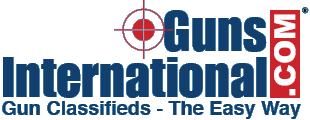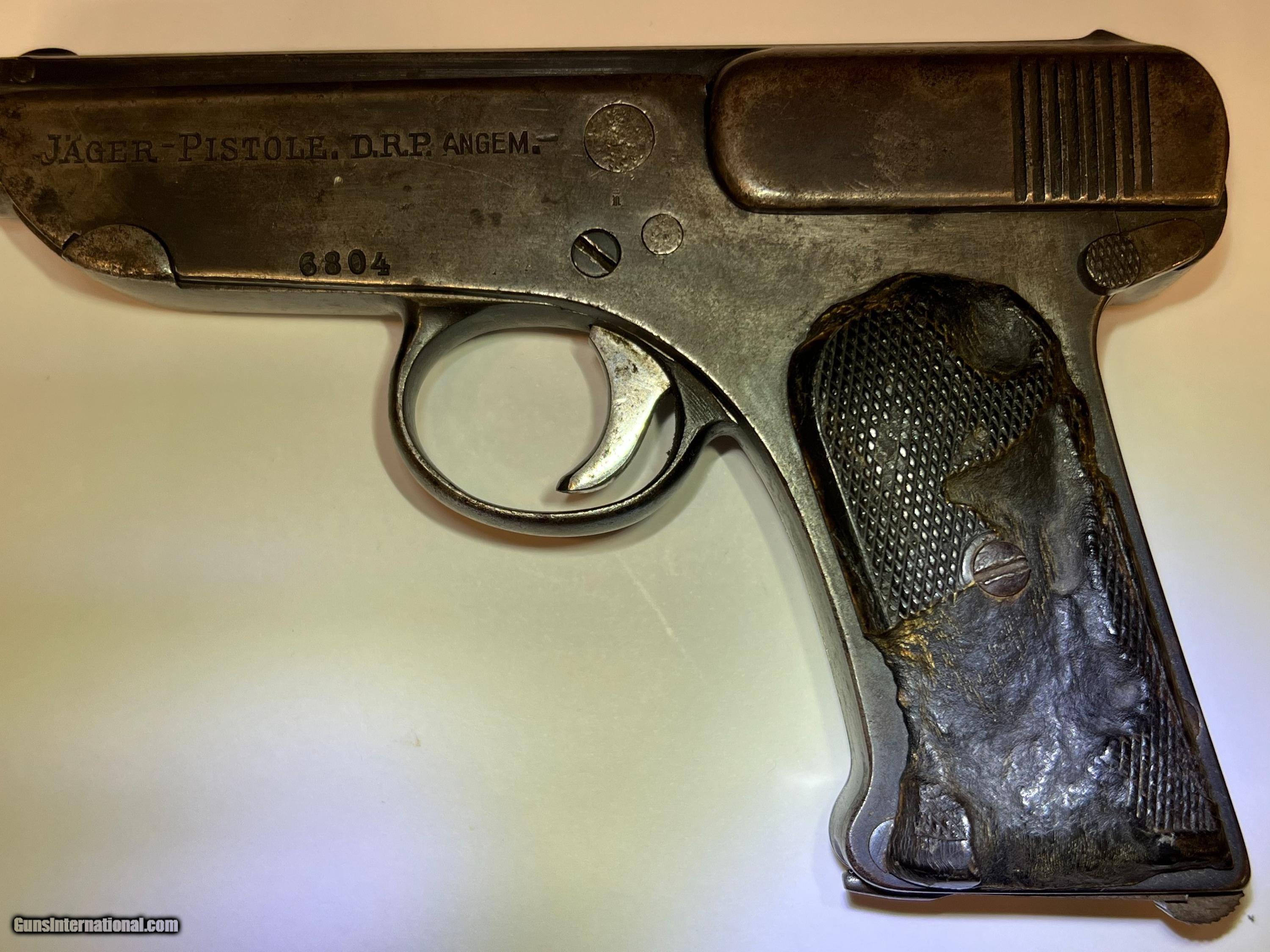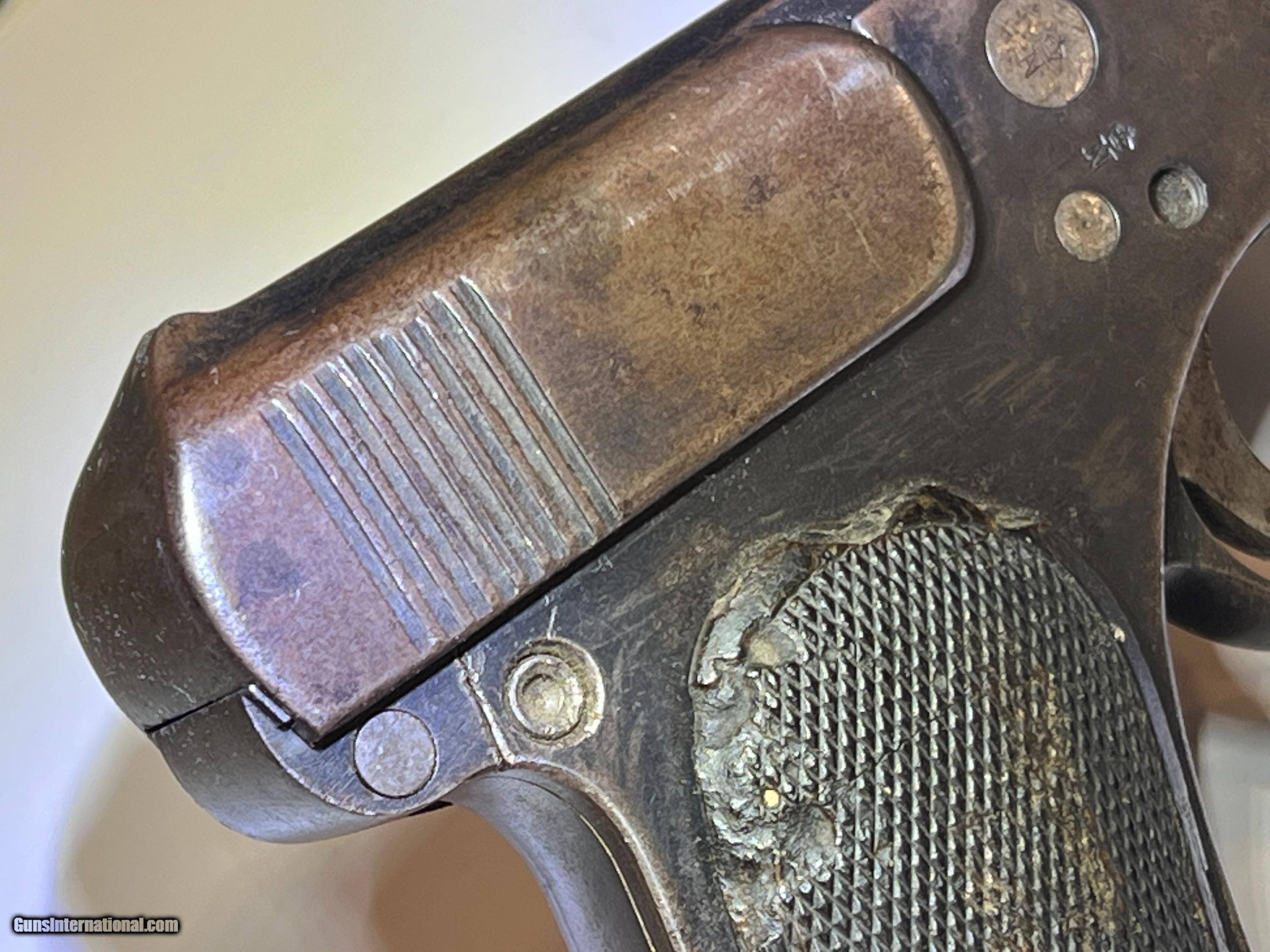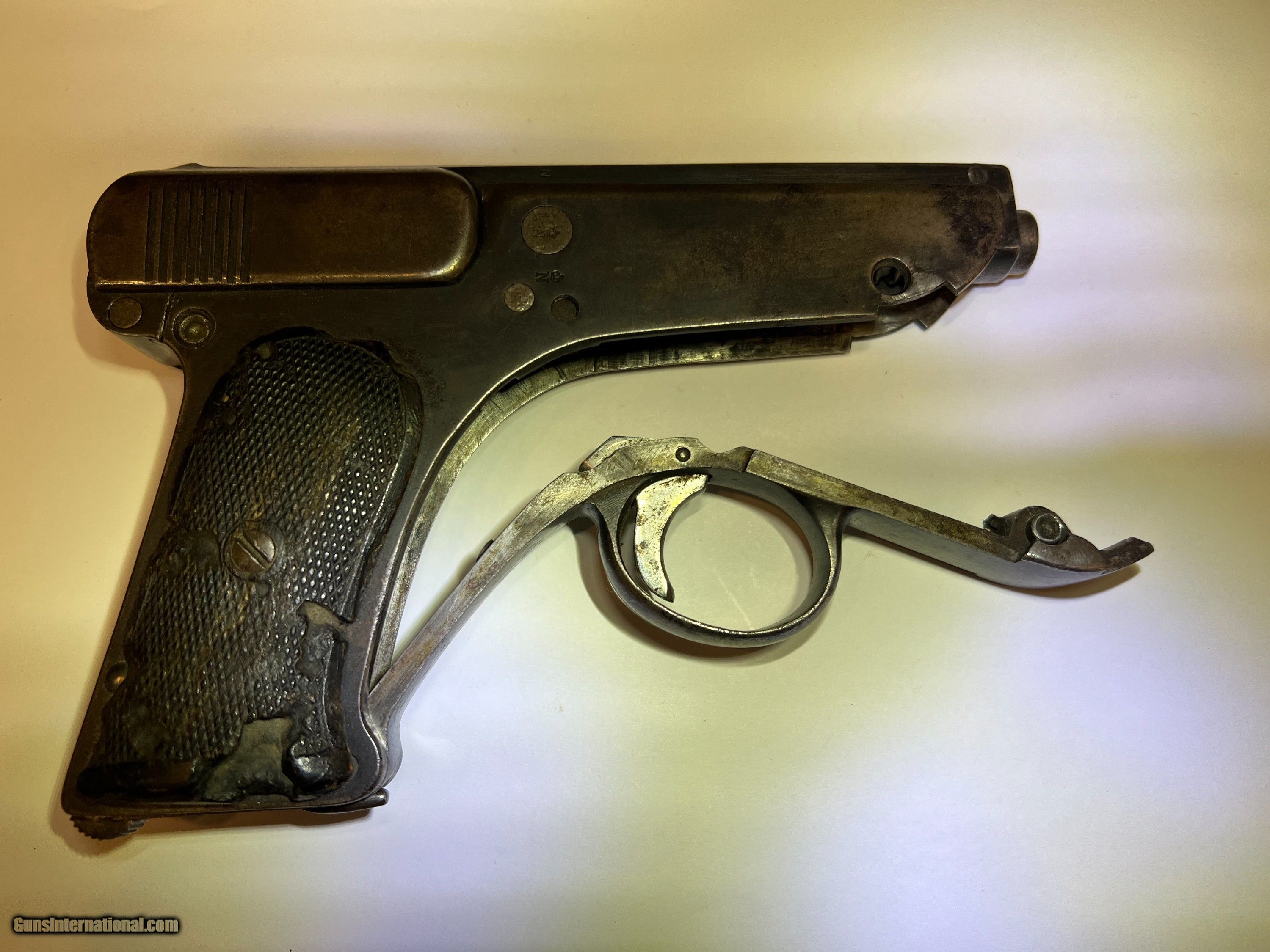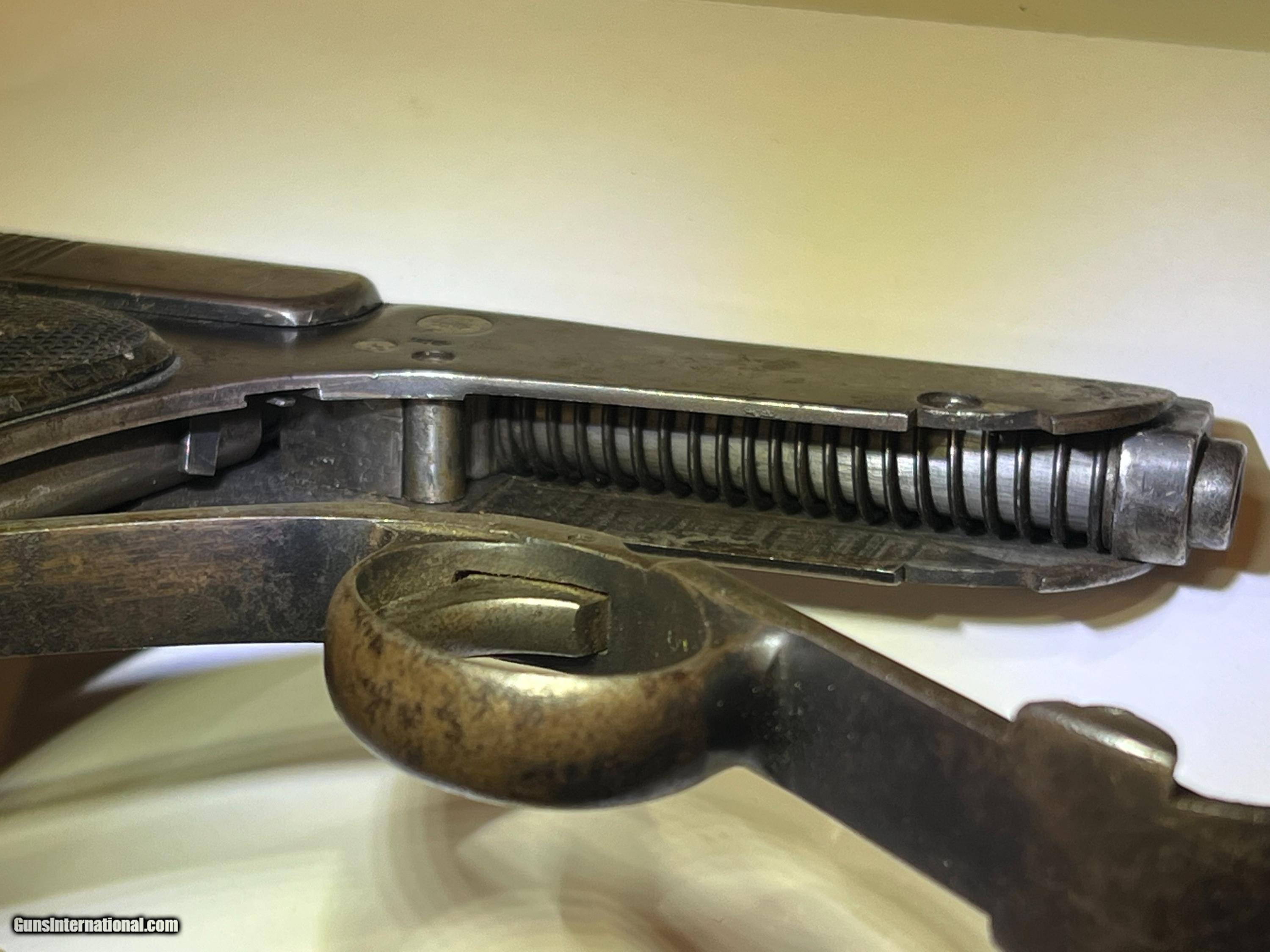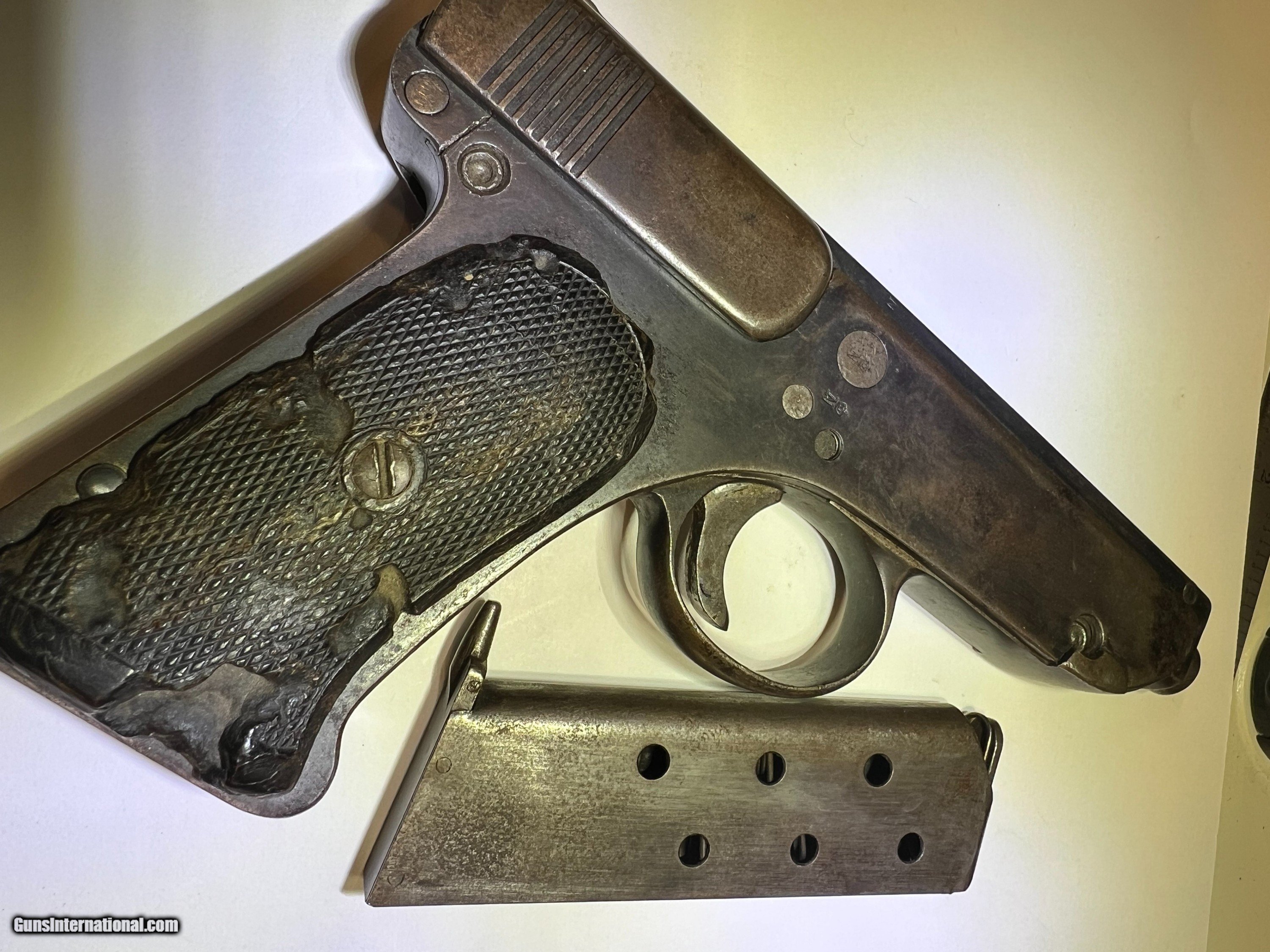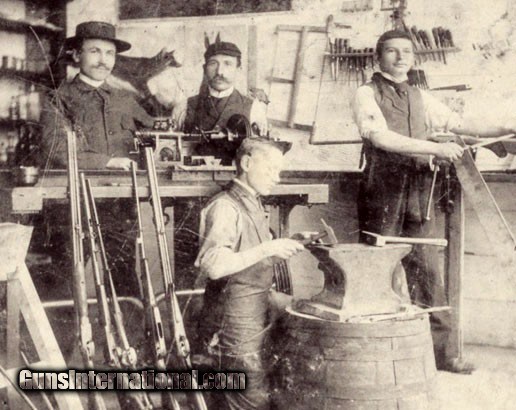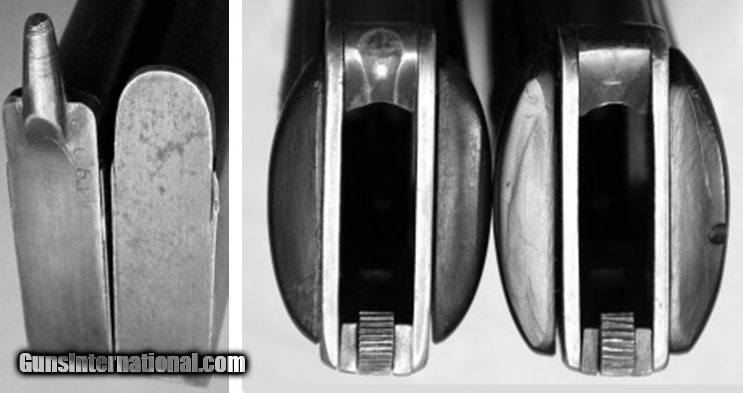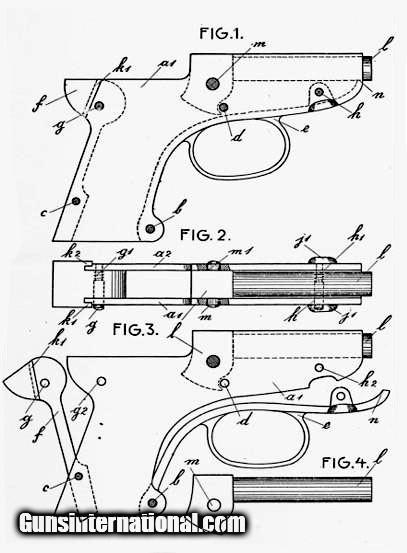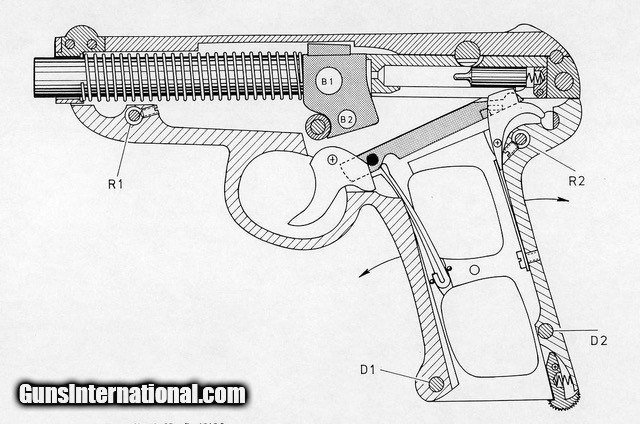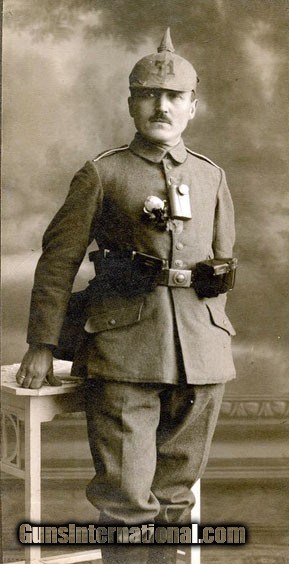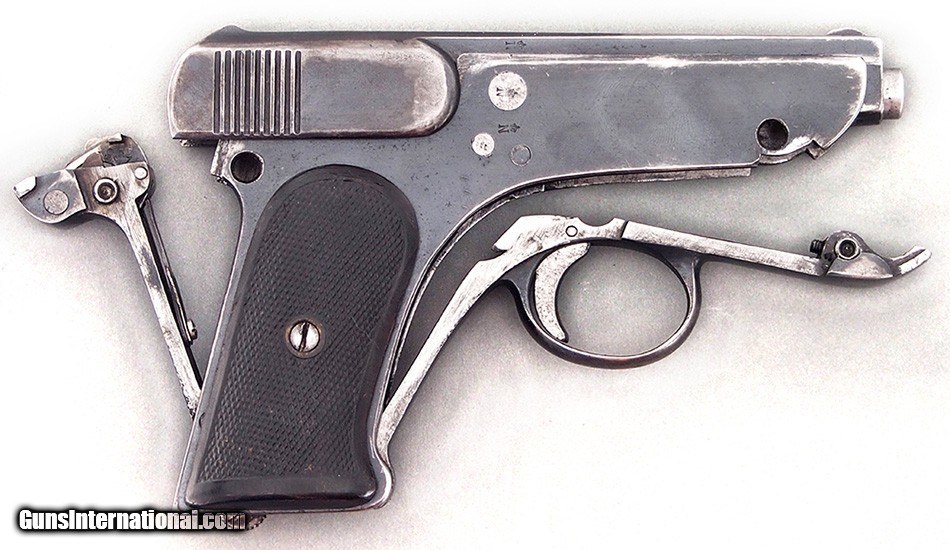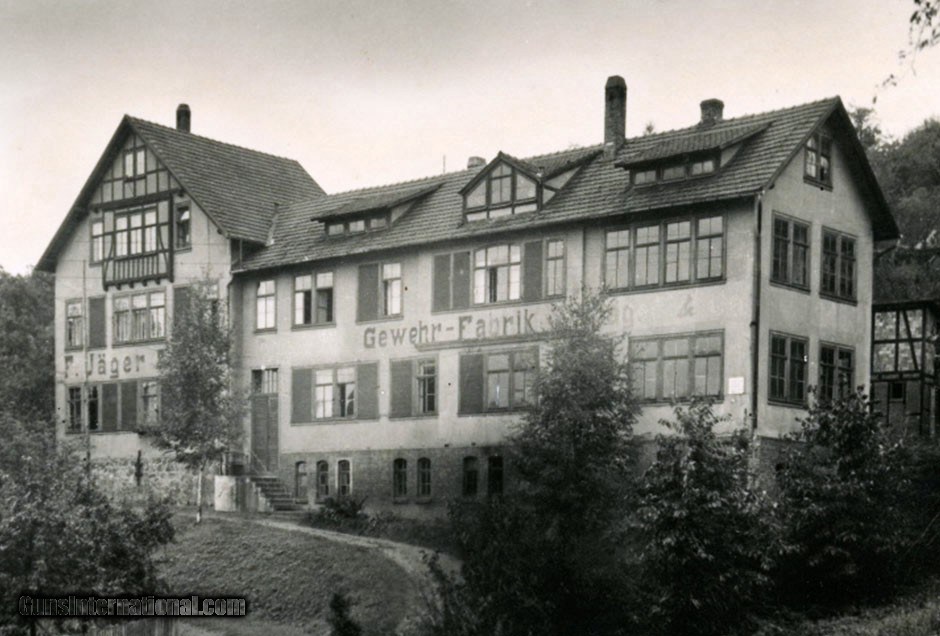Your Session is Ending
 The server has not detected any activity for the last 3 hours.
For your security, your session will expire in 2 minutes and you will be redirected to the Sign In page.
Would you like to stay signed in?
The server has not detected any activity for the last 3 hours.
For your security, your session will expire in 2 minutes and you will be redirected to the Sign In page.
Would you like to stay signed in?
Franz Jager 7.65mm automatic pistol / stamped metal production for sale
Franz Jager 7.65mm automatic pistol / stamped metal production for sale
Guns International #: 103060028
Seller's Inventory #: 877
Category - Handguns - German Pistols
- Antiques
Franz Jager 7.65mm automatic pistol / stamped metal production
Description:
The Jager pistol was made during the first world war by Franz Jager of Saul. It was an unusual pistol, well in advance of its time since it was largely put together from stamp metal components, a technique, which did not meet with general approval until the 1940's. The pistol was built up from two steel sideplates, which made up the butt and frame sides. Inside these plates locating pins held the parts of the firing mechanism, while two holes excepted a crossbar on the barrel breech and positively located the barrel. The sideplates were held at the correct spacing by front and back straps held in place by pins and screws. The side was pressed -steel unit with a solid breech-block held inside by screws. The calibre was 7.65 mm and a butt-mounted magazine carried 7 cartridges. It is believed that fewer than 6000 were made, and little is known about their distribution. It is probable that the design was intended to be offered to the Army, but it failed to meet with official approval and was sold commercially to Officers and soldiers.
Franz Jäger’s Self Loading Pistol
By Ron Schappaugh and Dr. Stefan Klein
Franz Jäger
The story of the Jäger pistol is the story of necessity being an angel of invention.
Franz Jäger was born March 19, 1876, near Rampitz, Germany. While Franz was a teenager, his uncle Gustav Adolph Kersten, a Prussian armorer, helped him find a gunsmith apprenticeship in Zella -Mehlis, a gun making center near Suhl. After completing his four-year apprenticeship, he opened his own gun shop in Halle and soon advertised a shotgun cocking system of his design. At the age of 23, he emigrated to the United States and worked as a gunsmith in New York City, where he began to develop and patent his ideas. The first was a selective single trigger mechanism for double barrel shotguns. Later, with Carl and Edmond Bittiner, he started a company “Bittiner and Jäger” near what is now New York City’s city hall.
In 1902, Franz and his new family left New York for Liege, Belgium. After a year, they moved to Suhl to find qualified craftsmen that could execute the shotguns he envisioned.The custom gun shop he established in Suhl quickly expanded, initially driven by installation of his single-triggers on guns made by other manufacturers. On the strength of this business and his other patents, he began making double shotguns and rifles. As he hired gunsmiths, his shop became too small, and in 1908 he formed a new company and built a factory which by 1914 had grown to over 50 employees. The Franz Jäger & Co. produced finely engraved double shotguns, rifles and combination guns with the brand name Herold. They were distinguished by their fine quality and innovative design, for which Jäger received numerous patents in Germany and abroad.
Everything changed on August 1, 1914 when Germany declared war on Russia and entered World War I. Shortly thereafter General von Falkenhayn, Kaiser Wilhelm’s Minister of War, decreed: “For the duration of hostilities all the hunting and sporting weapons factories are to be obliged to produce for military needs." Jäger lacked a design for a military weapon and also the milling and broaching machines necessary to make one. He was faced with closing his business and laying off his workers including his three brothers, Karl, Paul and Reinhold. The company desperately needed a military firearm design that its workers could make using existing equipment. Behold the angel.
From his experience making double guns Jäger knew how to die-cut parts and how to design forgings that required minimal machining. According to his son Kurt, “After the last workers left the factory on a Friday evening, he talked with my mother, got himself some food and a few bottles of beer and then locked himself in the workshop. He already had the concept for a pistol and its components almost completely worked out in his mind. So, he went to work to make the parts. Early Monday morning, he left the shop with unkempt hair, unshaven and exhausted. But he had a smile on his face, and in his hand was the first prototype of the Jäger Self- Loading Pistol.” During the next weeks, design details were worked out, dies made and forgings ordered.
Jäger applied for a German patent on November 30, 1914, which was rejected on February 8, 1916, on the grounds that there was nothing unique about the design. Jäger’s claim that his design with a frame consisting of side-plates and spacers, which are connected by screws was dismissed as “differing from existing methods by only simple structural measures, which are within the ordinary skill of the art.” The rejection of his application for a US patent noted that Jäger’s claimed ideas were already covered by Patent Number 1,059,405 for the Sprague Folding Pistol.
The German Army’s evaluation was equally unenthusiastic, dismissing his design as “only from sheet metal.” But, the army approved the Jäger along with 26 other pistols as acceptable for private purchase by military officers. Officers reportedly purchased approximately 2,000 pistols for the price of 33 marks. The one party impressed by the design and eager to manufacture the pistol was the Krieghoff company, also located in Suhl. They may even have assisted with the patent costs, but once the patent was denied they lost interest.
Production started in October 1914 and ended in 1917. In three years, approximately 13,000 pistols were produced. During the war, the factory also designed and produced a simple flare pistol. As the war progressed, Jäger’s brother Paul joined the army and was killed in 1914, and his brother Reinhold was drafted. In the spring of 1916, Franz Jäger himself was drafted and served in Infantry Regiment 71 in Erfurt, leaving only Karl, with little business experience, in charge.
The Jäger pistol was a modest commercial success, selling approximately 11,000 civilian pistols. And while the rejection of his patent left Franz without protection for his design, it did not prevent him from manufacturing the pistol. It seems obvious Franz Jäger never had any interest in manufacturing handguns other than to save his company. Following WWI his family business focused on unique high quality sporting shotguns and rifles. However, along with many other small firearms firms, the company never fully recovered. Franz Jäger died in 1957 but the Jäger name continued to be associated with quality hunting arms for decades under several companies guided by his sons Paul and Kurt.
Handgun Caliber: .32 ACP (7.65x17mm Browning SR)
Manufacturer: Franz Jäger & Co. Factory in Suhl
Model: Jager
Serial Number: 6804
Barrel Length: 3.8inches
Bore Info: good
Condition: good
Action: good
Price: $2,200.00
Description:
The Jager pistol was made during the first world war by Franz Jager of Saul. It was an unusual pistol, well in advance of its time since it was largely put together from stamp metal components, a technique, which did not meet with general approval until the 1940's. The pistol was built up from two steel sideplates, which made up the butt and frame sides. Inside these plates locating pins held the parts of the firing mechanism, while two holes excepted a crossbar on the barrel breech and positively located the barrel. The sideplates were held at the correct spacing by front and back straps held in place by pins and screws. The side was pressed -steel unit with a solid breech-block held inside by screws. The calibre was 7.65 mm and a butt-mounted magazine carried 7 cartridges. It is believed that fewer than 6000 were made, and little is known about their distribution. It is probable that the design was intended to be offered to the Army, but it failed to meet with official approval and was sold commercially to Officers and soldiers.
Franz Jäger’s Self Loading Pistol
By Ron Schappaugh and Dr. Stefan Klein
Franz Jäger
The story of the Jäger pistol is the story of necessity being an angel of invention.
Franz Jäger was born March 19, 1876, near Rampitz, Germany. While Franz was a teenager, his uncle Gustav Adolph Kersten, a Prussian armorer, helped him find a gunsmith apprenticeship in Zella -Mehlis, a gun making center near Suhl. After completing his four-year apprenticeship, he opened his own gun shop in Halle and soon advertised a shotgun cocking system of his design. At the age of 23, he emigrated to the United States and worked as a gunsmith in New York City, where he began to develop and patent his ideas. The first was a selective single trigger mechanism for double barrel shotguns. Later, with Carl and Edmond Bittiner, he started a company “Bittiner and Jäger” near what is now New York City’s city hall.
In 1902, Franz and his new family left New York for Liege, Belgium. After a year, they moved to Suhl to find qualified craftsmen that could execute the shotguns he envisioned.The custom gun shop he established in Suhl quickly expanded, initially driven by installation of his single-triggers on guns made by other manufacturers. On the strength of this business and his other patents, he began making double shotguns and rifles. As he hired gunsmiths, his shop became too small, and in 1908 he formed a new company and built a factory which by 1914 had grown to over 50 employees. The Franz Jäger & Co. produced finely engraved double shotguns, rifles and combination guns with the brand name Herold. They were distinguished by their fine quality and innovative design, for which Jäger received numerous patents in Germany and abroad.
Everything changed on August 1, 1914 when Germany declared war on Russia and entered World War I. Shortly thereafter General von Falkenhayn, Kaiser Wilhelm’s Minister of War, decreed: “For the duration of hostilities all the hunting and sporting weapons factories are to be obliged to produce for military needs." Jäger lacked a design for a military weapon and also the milling and broaching machines necessary to make one. He was faced with closing his business and laying off his workers including his three brothers, Karl, Paul and Reinhold. The company desperately needed a military firearm design that its workers could make using existing equipment. Behold the angel.
From his experience making double guns Jäger knew how to die-cut parts and how to design forgings that required minimal machining. According to his son Kurt, “After the last workers left the factory on a Friday evening, he talked with my mother, got himself some food and a few bottles of beer and then locked himself in the workshop. He already had the concept for a pistol and its components almost completely worked out in his mind. So, he went to work to make the parts. Early Monday morning, he left the shop with unkempt hair, unshaven and exhausted. But he had a smile on his face, and in his hand was the first prototype of the Jäger Self- Loading Pistol.” During the next weeks, design details were worked out, dies made and forgings ordered.
Jäger applied for a German patent on November 30, 1914, which was rejected on February 8, 1916, on the grounds that there was nothing unique about the design. Jäger’s claim that his design with a frame consisting of side-plates and spacers, which are connected by screws was dismissed as “differing from existing methods by only simple structural measures, which are within the ordinary skill of the art.” The rejection of his application for a US patent noted that Jäger’s claimed ideas were already covered by Patent Number 1,059,405 for the Sprague Folding Pistol.
The German Army’s evaluation was equally unenthusiastic, dismissing his design as “only from sheet metal.” But, the army approved the Jäger along with 26 other pistols as acceptable for private purchase by military officers. Officers reportedly purchased approximately 2,000 pistols for the price of 33 marks. The one party impressed by the design and eager to manufacture the pistol was the Krieghoff company, also located in Suhl. They may even have assisted with the patent costs, but once the patent was denied they lost interest.
Production started in October 1914 and ended in 1917. In three years, approximately 13,000 pistols were produced. During the war, the factory also designed and produced a simple flare pistol. As the war progressed, Jäger’s brother Paul joined the army and was killed in 1914, and his brother Reinhold was drafted. In the spring of 1916, Franz Jäger himself was drafted and served in Infantry Regiment 71 in Erfurt, leaving only Karl, with little business experience, in charge.
The Jäger pistol was a modest commercial success, selling approximately 11,000 civilian pistols. And while the rejection of his patent left Franz without protection for his design, it did not prevent him from manufacturing the pistol. It seems obvious Franz Jäger never had any interest in manufacturing handguns other than to save his company. Following WWI his family business focused on unique high quality sporting shotguns and rifles. However, along with many other small firearms firms, the company never fully recovered. Franz Jäger died in 1957 but the Jäger name continued to be associated with quality hunting arms for decades under several companies guided by his sons Paul and Kurt.
Handgun Caliber: .32 ACP (7.65x17mm Browning SR)
Manufacturer: Franz Jäger & Co. Factory in Suhl
Model: Jager
Serial Number: 6804
Barrel Length: 3.8inches
Bore Info: good
Condition: good
Action: good
Price: $2,200.00
Contact Seller
Click Photo to Enlarge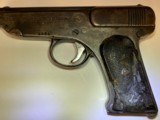

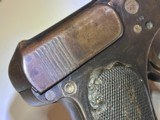
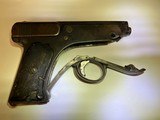
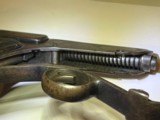
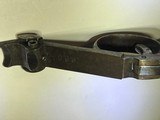
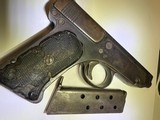
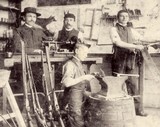
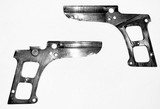

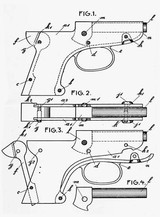
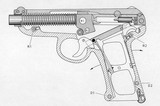
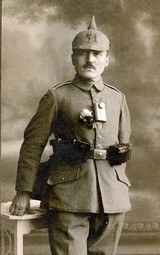

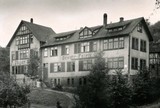
|
Guns International #: 103060028
Category - Handguns - German Pistols
- Antiques
Franz Jager 7.65mm automatic pistol / stamped metal production
Description: The Jager pistol was made during the first world war by Franz Jager of Saul. It was an unusual pistol, well in advance of its time since it was largely put together from stamp metal components, a technique, which did not meet with general approval until the 1940's. The pistol was built up from two steel sideplates, which made up the butt and frame sides. Inside these plates locating pins held the parts of the firing mechanism, while two holes excepted a crossbar on the barrel breech and positively located the barrel. The sideplates were held at the correct spacing by front and back straps held in place by pins and screws. The side was pressed -steel unit with a solid breech-block held inside by screws. The calibre was 7.65 mm and a butt-mounted magazine carried 7 cartridges. It is believed that fewer than 6000 were made, and little is known about their distribution. It is probable that the design was intended to be offered to the Army, but it failed to meet with official approval and was sold commercially to Officers and soldiers. Franz Jäger’s Self Loading Pistol By Ron Schappaugh and Dr. Stefan Klein Franz Jäger The story of the Jäger pistol is the story of necessity being an angel of invention. Franz Jäger was born March 19, 1876, near Rampitz, Germany. While Franz was a teenager, his uncle Gustav Adolph Kersten, a Prussian armorer, helped him find a gunsmith apprenticeship in Zella -Mehlis, a gun making center near Suhl. After completing his four-year apprenticeship, he opened his own gun shop in Halle and soon advertised a shotgun cocking system of his design. At the age of 23, he emigrated to the United States and worked as a gunsmith in New York City, where he began to develop and patent his ideas. The first was a selective single trigger mechanism for double barrel shotguns. Later, with Carl and Edmond Bittiner, he started a company “Bittiner and Jäger” near what is now New York City’s city hall. In 1902, Franz and his new family left New York for Liege, Belgium. After a year, they moved to Suhl to find qualified craftsmen that could execute the shotguns he envisioned.The custom gun shop he established in Suhl quickly expanded, initially driven by installation of his single-triggers on guns made by other manufacturers. On the strength of this business and his other patents, he began making double shotguns and rifles. As he hired gunsmiths, his shop became too small, and in 1908 he formed a new company and built a factory which by 1914 had grown to over 50 employees. The Franz Jäger & Co. produced finely engraved double shotguns, rifles and combination guns with the brand name Herold. They were distinguished by their fine quality and innovative design, for which Jäger received numerous patents in Germany and abroad. Everything changed on August 1, 1914 when Germany declared war on Russia and entered World War I. Shortly thereafter General von Falkenhayn, Kaiser Wilhelm’s Minister of War, decreed: “For the duration of hostilities all the hunting and sporting weapons factories are to be obliged to produce for military needs." Jäger lacked a design for a military weapon and also the milling and broaching machines necessary to make one. He was faced with closing his business and laying off his workers including his three brothers, Karl, Paul and Reinhold. The company desperately needed a military firearm design that its workers could make using existing equipment. Behold the angel. From his experience making double guns Jäger knew how to die-cut parts and how to design forgings that required minimal machining. According to his son Kurt, “After the last workers left the factory on a Friday evening, he talked with my mother, got himself some food and a few bottles of beer and then locked himself in the workshop. He already had the concept for a pistol and its components almost completely worked out in his mind. So, he went to work to make the parts. Early Monday morning, he left the shop with unkempt hair, unshaven and exhausted. But he had a smile on his face, and in his hand was the first prototype of the Jäger Self- Loading Pistol.” During the next weeks, design details were worked out, dies made and forgings ordered. Jäger applied for a German patent on November 30, 1914, which was rejected on February 8, 1916, on the grounds that there was nothing unique about the design. Jäger’s claim that his design with a frame consisting of side-plates and spacers, which are connected by screws was dismissed as “differing from existing methods by only simple structural measures, which are within the ordinary skill of the art.” The rejection of his application for a US patent noted that Jäger’s claimed ideas were already covered by Patent Number 1,059,405 for the Sprague Folding Pistol. The German Army’s evaluation was equally unenthusiastic, dismissing his design as “only from sheet metal.” But, the army approved the Jäger along with 26 other pistols as acceptable for private purchase by military officers. Officers reportedly purchased approximately 2,000 pistols for the price of 33 marks. The one party impressed by the design and eager to manufacture the pistol was the Krieghoff company, also located in Suhl. They may even have assisted with the patent costs, but once the patent was denied they lost interest. Production started in October 1914 and ended in 1917. In three years, approximately 13,000 pistols were produced. During the war, the factory also designed and produced a simple flare pistol. As the war progressed, Jäger’s brother Paul joined the army and was killed in 1914, and his brother Reinhold was drafted. In the spring of 1916, Franz Jäger himself was drafted and served in Infantry Regiment 71 in Erfurt, leaving only Karl, with little business experience, in charge. The Jäger pistol was a modest commercial success, selling approximately 11,000 civilian pistols. And while the rejection of his patent left Franz without protection for his design, it did not prevent him from manufacturing the pistol. It seems obvious Franz Jäger never had any interest in manufacturing handguns other than to save his company. Following WWI his family business focused on unique high quality sporting shotguns and rifles. However, along with many other small firearms firms, the company never fully recovered. Franz Jäger died in 1957 but the Jäger name continued to be associated with quality hunting arms for decades under several companies guided by his sons Paul and Kurt. Handgun Caliber: .32 ACP (7.65x17mm Browning SR) Manufacturer: Franz Jäger & Co. Factory in Suhl Model: Jager Serial Number: 6804 Barrel Length: 3.8inches Bore Info: good Condition: good Action: good Price: $2,200.00 Contact Seller |
Guns International #: 103060028
Seller's Inventory #: 877
Category - Handguns - German Pistols
- Antiques
Franz Jager 7.65mm automatic pistol / stamped metal production
Description:
The Jager pistol was made during the first world war by Franz Jager of Saul. It was an unusual pistol, well in advance of its time since it was largely put together from stamp metal components, a technique, which did not meet with general approval until the 1940's. The pistol was built up from two steel sideplates, which made up the butt and frame sides. Inside these plates locating pins held the parts of the firing mechanism, while two holes excepted a crossbar on the barrel breech and positively located the barrel. The sideplates were held at the correct spacing by front and back straps held in place by pins and screws. The side was pressed -steel unit with a solid breech-block held inside by screws. The calibre was 7.65 mm and a butt-mounted magazine carried 7 cartridges. It is believed that fewer than 6000 were made, and little is known about their distribution. It is probable that the design was intended to be offered to the Army, but it failed to meet with official approval and was sold commercially to Officers and soldiers.
Franz Jäger’s Self Loading Pistol
By Ron Schappaugh and Dr. Stefan Klein
Franz Jäger
The story of the Jäger pistol is the story of necessity being an angel of invention.
Franz Jäger was born March 19, 1876, near Rampitz, Germany. While Franz was a teenager, his uncle Gustav Adolph Kersten, a Prussian armorer, helped him find a gunsmith apprenticeship in Zella -Mehlis, a gun making center near Suhl. After completing his four-year apprenticeship, he opened his own gun shop in Halle and soon advertised a shotgun cocking system of his design. At the age of 23, he emigrated to the United States and worked as a gunsmith in New York City, where he began to develop and patent his ideas. The first was a selective single trigger mechanism for double barrel shotguns. Later, with Carl and Edmond Bittiner, he started a company “Bittiner and Jäger” near what is now New York City’s city hall.
In 1902, Franz and his new family left New York for Liege, Belgium. After a year, they moved to Suhl to find qualified craftsmen that could execute the shotguns he envisioned.The custom gun shop he established in Suhl quickly expanded, initially driven by installation of his single-triggers on guns made by other manufacturers. On the strength of this business and his other patents, he began making double shotguns and rifles. As he hired gunsmiths, his shop became too small, and in 1908 he formed a new company and built a factory which by 1914 had grown to over 50 employees. The Franz Jäger & Co. produced finely engraved double shotguns, rifles and combination guns with the brand name Herold. They were distinguished by their fine quality and innovative design, for which Jäger received numerous patents in Germany and abroad.
Everything changed on August 1, 1914 when Germany declared war on Russia and entered World War I. Shortly thereafter General von Falkenhayn, Kaiser Wilhelm’s Minister of War, decreed: “For the duration of hostilities all the hunting and sporting weapons factories are to be obliged to produce for military needs." Jäger lacked a design for a military weapon and also the milling and broaching machines necessary to make one. He was faced with closing his business and laying off his workers including his three brothers, Karl, Paul and Reinhold. The company desperately needed a military firearm design that its workers could make using existing equipment. Behold the angel.
From his experience making double guns Jäger knew how to die-cut parts and how to design forgings that required minimal machining. According to his son Kurt, “After the last workers left the factory on a Friday evening, he talked with my mother, got himself some food and a few bottles of beer and then locked himself in the workshop. He already had the concept for a pistol and its components almost completely worked out in his mind. So, he went to work to make the parts. Early Monday morning, he left the shop with unkempt hair, unshaven and exhausted. But he had a smile on his face, and in his hand was the first prototype of the Jäger Self- Loading Pistol.” During the next weeks, design details were worked out, dies made and forgings ordered.
Jäger applied for a German patent on November 30, 1914, which was rejected on February 8, 1916, on the grounds that there was nothing unique about the design. Jäger’s claim that his design with a frame consisting of side-plates and spacers, which are connected by screws was dismissed as “differing from existing methods by only simple structural measures, which are within the ordinary skill of the art.” The rejection of his application for a US patent noted that Jäger’s claimed ideas were already covered by Patent Number 1,059,405 for the Sprague Folding Pistol.
The German Army’s evaluation was equally unenthusiastic, dismissing his design as “only from sheet metal.” But, the army approved the Jäger along with 26 other pistols as acceptable for private purchase by military officers. Officers reportedly purchased approximately 2,000 pistols for the price of 33 marks. The one party impressed by the design and eager to manufacture the pistol was the Krieghoff company, also located in Suhl. They may even have assisted with the patent costs, but once the patent was denied they lost interest.
Production started in October 1914 and ended in 1917. In three years, approximately 13,000 pistols were produced. During the war, the factory also designed and produced a simple flare pistol. As the war progressed, Jäger’s brother Paul joined the army and was killed in 1914, and his brother Reinhold was drafted. In the spring of 1916, Franz Jäger himself was drafted and served in Infantry Regiment 71 in Erfurt, leaving only Karl, with little business experience, in charge.
The Jäger pistol was a modest commercial success, selling approximately 11,000 civilian pistols. And while the rejection of his patent left Franz without protection for his design, it did not prevent him from manufacturing the pistol. It seems obvious Franz Jäger never had any interest in manufacturing handguns other than to save his company. Following WWI his family business focused on unique high quality sporting shotguns and rifles. However, along with many other small firearms firms, the company never fully recovered. Franz Jäger died in 1957 but the Jäger name continued to be associated with quality hunting arms for decades under several companies guided by his sons Paul and Kurt.
Handgun Caliber: .32 ACP (7.65x17mm Browning SR)
Manufacturer: Franz Jäger & Co. Factory in Suhl
Model: Jager
Serial Number: 6804
Barrel Length: 3.8inches
Bore Info: good
Condition: good
Action: good
Price: $2,200.00
Description:
The Jager pistol was made during the first world war by Franz Jager of Saul. It was an unusual pistol, well in advance of its time since it was largely put together from stamp metal components, a technique, which did not meet with general approval until the 1940's. The pistol was built up from two steel sideplates, which made up the butt and frame sides. Inside these plates locating pins held the parts of the firing mechanism, while two holes excepted a crossbar on the barrel breech and positively located the barrel. The sideplates were held at the correct spacing by front and back straps held in place by pins and screws. The side was pressed -steel unit with a solid breech-block held inside by screws. The calibre was 7.65 mm and a butt-mounted magazine carried 7 cartridges. It is believed that fewer than 6000 were made, and little is known about their distribution. It is probable that the design was intended to be offered to the Army, but it failed to meet with official approval and was sold commercially to Officers and soldiers.
Franz Jäger’s Self Loading Pistol
By Ron Schappaugh and Dr. Stefan Klein
Franz Jäger
The story of the Jäger pistol is the story of necessity being an angel of invention.
Franz Jäger was born March 19, 1876, near Rampitz, Germany. While Franz was a teenager, his uncle Gustav Adolph Kersten, a Prussian armorer, helped him find a gunsmith apprenticeship in Zella -Mehlis, a gun making center near Suhl. After completing his four-year apprenticeship, he opened his own gun shop in Halle and soon advertised a shotgun cocking system of his design. At the age of 23, he emigrated to the United States and worked as a gunsmith in New York City, where he began to develop and patent his ideas. The first was a selective single trigger mechanism for double barrel shotguns. Later, with Carl and Edmond Bittiner, he started a company “Bittiner and Jäger” near what is now New York City’s city hall.
In 1902, Franz and his new family left New York for Liege, Belgium. After a year, they moved to Suhl to find qualified craftsmen that could execute the shotguns he envisioned.The custom gun shop he established in Suhl quickly expanded, initially driven by installation of his single-triggers on guns made by other manufacturers. On the strength of this business and his other patents, he began making double shotguns and rifles. As he hired gunsmiths, his shop became too small, and in 1908 he formed a new company and built a factory which by 1914 had grown to over 50 employees. The Franz Jäger & Co. produced finely engraved double shotguns, rifles and combination guns with the brand name Herold. They were distinguished by their fine quality and innovative design, for which Jäger received numerous patents in Germany and abroad.
Everything changed on August 1, 1914 when Germany declared war on Russia and entered World War I. Shortly thereafter General von Falkenhayn, Kaiser Wilhelm’s Minister of War, decreed: “For the duration of hostilities all the hunting and sporting weapons factories are to be obliged to produce for military needs." Jäger lacked a design for a military weapon and also the milling and broaching machines necessary to make one. He was faced with closing his business and laying off his workers including his three brothers, Karl, Paul and Reinhold. The company desperately needed a military firearm design that its workers could make using existing equipment. Behold the angel.
From his experience making double guns Jäger knew how to die-cut parts and how to design forgings that required minimal machining. According to his son Kurt, “After the last workers left the factory on a Friday evening, he talked with my mother, got himself some food and a few bottles of beer and then locked himself in the workshop. He already had the concept for a pistol and its components almost completely worked out in his mind. So, he went to work to make the parts. Early Monday morning, he left the shop with unkempt hair, unshaven and exhausted. But he had a smile on his face, and in his hand was the first prototype of the Jäger Self- Loading Pistol.” During the next weeks, design details were worked out, dies made and forgings ordered.
Jäger applied for a German patent on November 30, 1914, which was rejected on February 8, 1916, on the grounds that there was nothing unique about the design. Jäger’s claim that his design with a frame consisting of side-plates and spacers, which are connected by screws was dismissed as “differing from existing methods by only simple structural measures, which are within the ordinary skill of the art.” The rejection of his application for a US patent noted that Jäger’s claimed ideas were already covered by Patent Number 1,059,405 for the Sprague Folding Pistol.
The German Army’s evaluation was equally unenthusiastic, dismissing his design as “only from sheet metal.” But, the army approved the Jäger along with 26 other pistols as acceptable for private purchase by military officers. Officers reportedly purchased approximately 2,000 pistols for the price of 33 marks. The one party impressed by the design and eager to manufacture the pistol was the Krieghoff company, also located in Suhl. They may even have assisted with the patent costs, but once the patent was denied they lost interest.
Production started in October 1914 and ended in 1917. In three years, approximately 13,000 pistols were produced. During the war, the factory also designed and produced a simple flare pistol. As the war progressed, Jäger’s brother Paul joined the army and was killed in 1914, and his brother Reinhold was drafted. In the spring of 1916, Franz Jäger himself was drafted and served in Infantry Regiment 71 in Erfurt, leaving only Karl, with little business experience, in charge.
The Jäger pistol was a modest commercial success, selling approximately 11,000 civilian pistols. And while the rejection of his patent left Franz without protection for his design, it did not prevent him from manufacturing the pistol. It seems obvious Franz Jäger never had any interest in manufacturing handguns other than to save his company. Following WWI his family business focused on unique high quality sporting shotguns and rifles. However, along with many other small firearms firms, the company never fully recovered. Franz Jäger died in 1957 but the Jäger name continued to be associated with quality hunting arms for decades under several companies guided by his sons Paul and Kurt.
Handgun Caliber: .32 ACP (7.65x17mm Browning SR)
Manufacturer: Franz Jäger & Co. Factory in Suhl
Model: Jager
Serial Number: 6804
Barrel Length: 3.8inches
Bore Info: good
Condition: good
Action: good
Price: $2,200.00
Guns International #: 103060028
Seller's Inventory #: 877


Guns International #: 103060028
Seller's Inventory #: 877
Category - Handguns - German Pistols
- Antiques
Franz Jager 7.65mm automatic pistol / stamped metal production
Description:
The Jager pistol was made during the first world war by Franz Jager of Saul. It was an unusual pistol, well in advance of its time since it was largely put together from stamp metal components, a technique, which did not meet with general approval until the 1940's. The pistol was built up from two steel sideplates, which made up the butt and frame sides. Inside these plates locating pins held the parts of the firing mechanism, while two holes excepted a crossbar on the barrel breech and positively located the barrel. The sideplates were held at the correct spacing by front and back straps held in place by pins and screws. The side was pressed -steel unit with a solid breech-block held inside by screws. The calibre was 7.65 mm and a butt-mounted magazine carried 7 cartridges. It is believed that fewer than 6000 were made, and little is known about their distribution. It is probable that the design was intended to be offered to the Army, but it failed to meet with official approval and was sold commercially to Officers and soldiers.
Franz Jäger’s Self Loading Pistol
By Ron Schappaugh and Dr. Stefan Klein
Franz Jäger
The story of the Jäger pistol is the story of necessity being an angel of invention.
Franz Jäger was born March 19, 1876, near Rampitz, Germany. While Franz was a teenager, his uncle Gustav Adolph Kersten, a Prussian armorer, helped him find a gunsmith apprenticeship in Zella -Mehlis, a gun making center near Suhl. After completing his four-year apprenticeship, he opened his own gun shop in Halle and soon advertised a shotgun cocking system of his design. At the age of 23, he emigrated to the United States and worked as a gunsmith in New York City, where he began to develop and patent his ideas. The first was a selective single trigger mechanism for double barrel shotguns. Later, with Carl and Edmond Bittiner, he started a company “Bittiner and Jäger” near what is now New York City’s city hall.
In 1902, Franz and his new family left New York for Liege, Belgium. After a year, they moved to Suhl to find qualified craftsmen that could execute the shotguns he envisioned.The custom gun shop he established in Suhl quickly expanded, initially driven by installation of his single-triggers on guns made by other manufacturers. On the strength of this business and his other patents, he began making double shotguns and rifles. As he hired gunsmiths, his shop became too small, and in 1908 he formed a new company and built a factory which by 1914 had grown to over 50 employees. The Franz Jäger & Co. produced finely engraved double shotguns, rifles and combination guns with the brand name Herold. They were distinguished by their fine quality and innovative design, for which Jäger received numerous patents in Germany and abroad.
Everything changed on August 1, 1914 when Germany declared war on Russia and entered World War I. Shortly thereafter General von Falkenhayn, Kaiser Wilhelm’s Minister of War, decreed: “For the duration of hostilities all the hunting and sporting weapons factories are to be obliged to produce for military needs." Jäger lacked a design for a military weapon and also the milling and broaching machines necessary to make one. He was faced with closing his business and laying off his workers including his three brothers, Karl, Paul and Reinhold. The company desperately needed a military firearm design that its workers could make using existing equipment. Behold the angel.
From his experience making double guns Jäger knew how to die-cut parts and how to design forgings that required minimal machining. According to his son Kurt, “After the last workers left the factory on a Friday evening, he talked with my mother, got himself some food and a few bottles of beer and then locked himself in the workshop. He already had the concept for a pistol and its components almost completely worked out in his mind. So, he went to work to make the parts. Early Monday morning, he left the shop with unkempt hair, unshaven and exhausted. But he had a smile on his face, and in his hand was the first prototype of the Jäger Self- Loading Pistol.” During the next weeks, design details were worked out, dies made and forgings ordered.
Jäger applied for a German patent on November 30, 1914, which was rejected on February 8, 1916, on the grounds that there was nothing unique about the design. Jäger’s claim that his design with a frame consisting of side-plates and spacers, which are connected by screws was dismissed as “differing from existing methods by only simple structural measures, which are within the ordinary skill of the art.” The rejection of his application for a US patent noted that Jäger’s claimed ideas were already covered by Patent Number 1,059,405 for the Sprague Folding Pistol.
The German Army’s evaluation was equally unenthusiastic, dismissing his design as “only from sheet metal.” But, the army approved the Jäger along with 26 other pistols as acceptable for private purchase by military officers. Officers reportedly purchased approximately 2,000 pistols for the price of 33 marks. The one party impressed by the design and eager to manufacture the pistol was the Krieghoff company, also located in Suhl. They may even have assisted with the patent costs, but once the patent was denied they lost interest.
Production started in October 1914 and ended in 1917. In three years, approximately 13,000 pistols were produced. During the war, the factory also designed and produced a simple flare pistol. As the war progressed, Jäger’s brother Paul joined the army and was killed in 1914, and his brother Reinhold was drafted. In the spring of 1916, Franz Jäger himself was drafted and served in Infantry Regiment 71 in Erfurt, leaving only Karl, with little business experience, in charge.
The Jäger pistol was a modest commercial success, selling approximately 11,000 civilian pistols. And while the rejection of his patent left Franz without protection for his design, it did not prevent him from manufacturing the pistol. It seems obvious Franz Jäger never had any interest in manufacturing handguns other than to save his company. Following WWI his family business focused on unique high quality sporting shotguns and rifles. However, along with many other small firearms firms, the company never fully recovered. Franz Jäger died in 1957 but the Jäger name continued to be associated with quality hunting arms for decades under several companies guided by his sons Paul and Kurt.
Handgun Caliber: .32 ACP (7.65x17mm Browning SR)
Manufacturer: Franz Jäger & Co. Factory in Suhl
Model: Jager
Serial Number: 6804
Barrel Length: 3.8inches
Bore Info: good
Condition: good
Action: good
Price: $2,200.00
Description:
The Jager pistol was made during the first world war by Franz Jager of Saul. It was an unusual pistol, well in advance of its time since it was largely put together from stamp metal components, a technique, which did not meet with general approval until the 1940's. The pistol was built up from two steel sideplates, which made up the butt and frame sides. Inside these plates locating pins held the parts of the firing mechanism, while two holes excepted a crossbar on the barrel breech and positively located the barrel. The sideplates were held at the correct spacing by front and back straps held in place by pins and screws. The side was pressed -steel unit with a solid breech-block held inside by screws. The calibre was 7.65 mm and a butt-mounted magazine carried 7 cartridges. It is believed that fewer than 6000 were made, and little is known about their distribution. It is probable that the design was intended to be offered to the Army, but it failed to meet with official approval and was sold commercially to Officers and soldiers.
Franz Jäger’s Self Loading Pistol
By Ron Schappaugh and Dr. Stefan Klein
Franz Jäger
The story of the Jäger pistol is the story of necessity being an angel of invention.
Franz Jäger was born March 19, 1876, near Rampitz, Germany. While Franz was a teenager, his uncle Gustav Adolph Kersten, a Prussian armorer, helped him find a gunsmith apprenticeship in Zella -Mehlis, a gun making center near Suhl. After completing his four-year apprenticeship, he opened his own gun shop in Halle and soon advertised a shotgun cocking system of his design. At the age of 23, he emigrated to the United States and worked as a gunsmith in New York City, where he began to develop and patent his ideas. The first was a selective single trigger mechanism for double barrel shotguns. Later, with Carl and Edmond Bittiner, he started a company “Bittiner and Jäger” near what is now New York City’s city hall.
In 1902, Franz and his new family left New York for Liege, Belgium. After a year, they moved to Suhl to find qualified craftsmen that could execute the shotguns he envisioned.The custom gun shop he established in Suhl quickly expanded, initially driven by installation of his single-triggers on guns made by other manufacturers. On the strength of this business and his other patents, he began making double shotguns and rifles. As he hired gunsmiths, his shop became too small, and in 1908 he formed a new company and built a factory which by 1914 had grown to over 50 employees. The Franz Jäger & Co. produced finely engraved double shotguns, rifles and combination guns with the brand name Herold. They were distinguished by their fine quality and innovative design, for which Jäger received numerous patents in Germany and abroad.
Everything changed on August 1, 1914 when Germany declared war on Russia and entered World War I. Shortly thereafter General von Falkenhayn, Kaiser Wilhelm’s Minister of War, decreed: “For the duration of hostilities all the hunting and sporting weapons factories are to be obliged to produce for military needs." Jäger lacked a design for a military weapon and also the milling and broaching machines necessary to make one. He was faced with closing his business and laying off his workers including his three brothers, Karl, Paul and Reinhold. The company desperately needed a military firearm design that its workers could make using existing equipment. Behold the angel.
From his experience making double guns Jäger knew how to die-cut parts and how to design forgings that required minimal machining. According to his son Kurt, “After the last workers left the factory on a Friday evening, he talked with my mother, got himself some food and a few bottles of beer and then locked himself in the workshop. He already had the concept for a pistol and its components almost completely worked out in his mind. So, he went to work to make the parts. Early Monday morning, he left the shop with unkempt hair, unshaven and exhausted. But he had a smile on his face, and in his hand was the first prototype of the Jäger Self- Loading Pistol.” During the next weeks, design details were worked out, dies made and forgings ordered.
Jäger applied for a German patent on November 30, 1914, which was rejected on February 8, 1916, on the grounds that there was nothing unique about the design. Jäger’s claim that his design with a frame consisting of side-plates and spacers, which are connected by screws was dismissed as “differing from existing methods by only simple structural measures, which are within the ordinary skill of the art.” The rejection of his application for a US patent noted that Jäger’s claimed ideas were already covered by Patent Number 1,059,405 for the Sprague Folding Pistol.
The German Army’s evaluation was equally unenthusiastic, dismissing his design as “only from sheet metal.” But, the army approved the Jäger along with 26 other pistols as acceptable for private purchase by military officers. Officers reportedly purchased approximately 2,000 pistols for the price of 33 marks. The one party impressed by the design and eager to manufacture the pistol was the Krieghoff company, also located in Suhl. They may even have assisted with the patent costs, but once the patent was denied they lost interest.
Production started in October 1914 and ended in 1917. In three years, approximately 13,000 pistols were produced. During the war, the factory also designed and produced a simple flare pistol. As the war progressed, Jäger’s brother Paul joined the army and was killed in 1914, and his brother Reinhold was drafted. In the spring of 1916, Franz Jäger himself was drafted and served in Infantry Regiment 71 in Erfurt, leaving only Karl, with little business experience, in charge.
The Jäger pistol was a modest commercial success, selling approximately 11,000 civilian pistols. And while the rejection of his patent left Franz without protection for his design, it did not prevent him from manufacturing the pistol. It seems obvious Franz Jäger never had any interest in manufacturing handguns other than to save his company. Following WWI his family business focused on unique high quality sporting shotguns and rifles. However, along with many other small firearms firms, the company never fully recovered. Franz Jäger died in 1957 but the Jäger name continued to be associated with quality hunting arms for decades under several companies guided by his sons Paul and Kurt.
Handgun Caliber: .32 ACP (7.65x17mm Browning SR)
Manufacturer: Franz Jäger & Co. Factory in Suhl
Model: Jager
Serial Number: 6804
Barrel Length: 3.8inches
Bore Info: good
Condition: good
Action: good
Price: $2,200.00
Contact Seller
Buy Now
Pay with GunTab
Guns International Advertising Policy
GunsInternational.com is the #1 Gun Classified website that brings gun buyers and gun brokers or sellers together through classifed advertising of guns, gun related items and services for sale online. If you are looking to buy guns or sell guns, you have come to the right place. GunsInternational.com gun classifieds currently have over 200,000 guns for sale online by numerous dealers and collectors alike. Guns International makes no representation or warranty as to the accuracy of the information contained in the gun classifieds, gun parts or gun services classifieds listings. Buyers and sellers are required to know and comply with all applicable local, state, federal and international firearm laws.
GunsInternational.com is the #1 Gun Classified website that brings gun buyers and gun brokers or sellers together through classifed advertising of guns, gun related items and services for sale online. If you are looking to buy guns or sell guns, you have come to the right place. GunsInternational.com gun classifieds currently have over 200,000 guns for sale online by numerous dealers and collectors alike. Guns International makes no representation or warranty as to the accuracy of the information contained in the gun classifieds, gun parts or gun services classifieds listings. Buyers and sellers are required to know and comply with all applicable local, state, federal and international firearm laws.
Listings
Home
New Today
New This Week
Rifles For Sale Online
Shotguns For Sale Online
Handguns For Sale Online
Pistols For Sale Online
Revolvers For Sale Online
NFA
Gun Parts For Sale Online
Services
Home
New Today
New This Week
Rifles For Sale Online
Shotguns For Sale Online
Handguns For Sale Online
Pistols For Sale Online
Revolvers For Sale Online
NFA
Gun Parts For Sale Online
Services
©2006 - 2025 all rights reserved. | Guns International.com | V4.1 ww3



Privacy Policy
User Agreement
FAQs
Contact Us
©2006 - 2025 all rights reserved.
Guns International.com | V4.1 ww3
Guns International.com | V4.1 ww3
